The Behavioristic Theory of Learning and Student Classroom Behavior
VerifiedAdded on 2020/04/13
|7
|1954
|95
Essay
AI Summary
This essay explores the behavioristic theory of learning, a psychological approach that emphasizes the role of environmental factors in shaping behavior. It examines key assumptions, such as the idea that behavior is learned from the environment and that psychology is an observational science. The essay defines behavior as a response to stimuli and discusses different types of behavior observed in classrooms, including those related to classical and operant conditioning. It highlights the importance of reinforcement and punishment in shaping student actions, referencing the laws of effect, exercise, and readiness. The essay also considers the influence of socio-cultural constructs on behavior, and argues that while environmental factors are significant, individual readiness and capacity also play a role in how students respond to learning situations. It concludes by emphasizing the diversity in student perspectives and the need for teachers to adapt their methods to cater to individual differences.
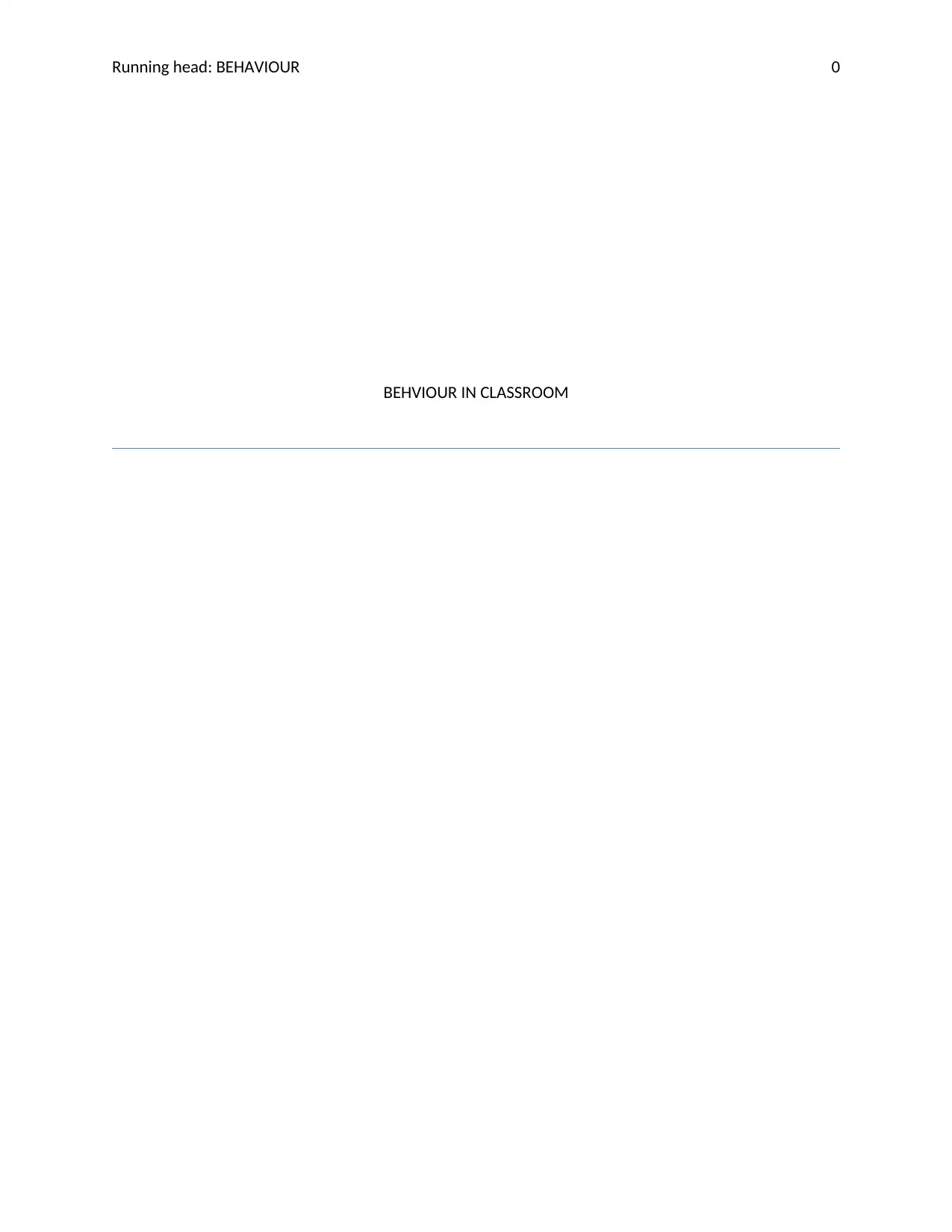
Running head: BEHAVIOUR 0
BEHVIOUR IN CLASSROOM
BEHVIOUR IN CLASSROOM
Paraphrase This Document
Need a fresh take? Get an instant paraphrase of this document with our AI Paraphraser
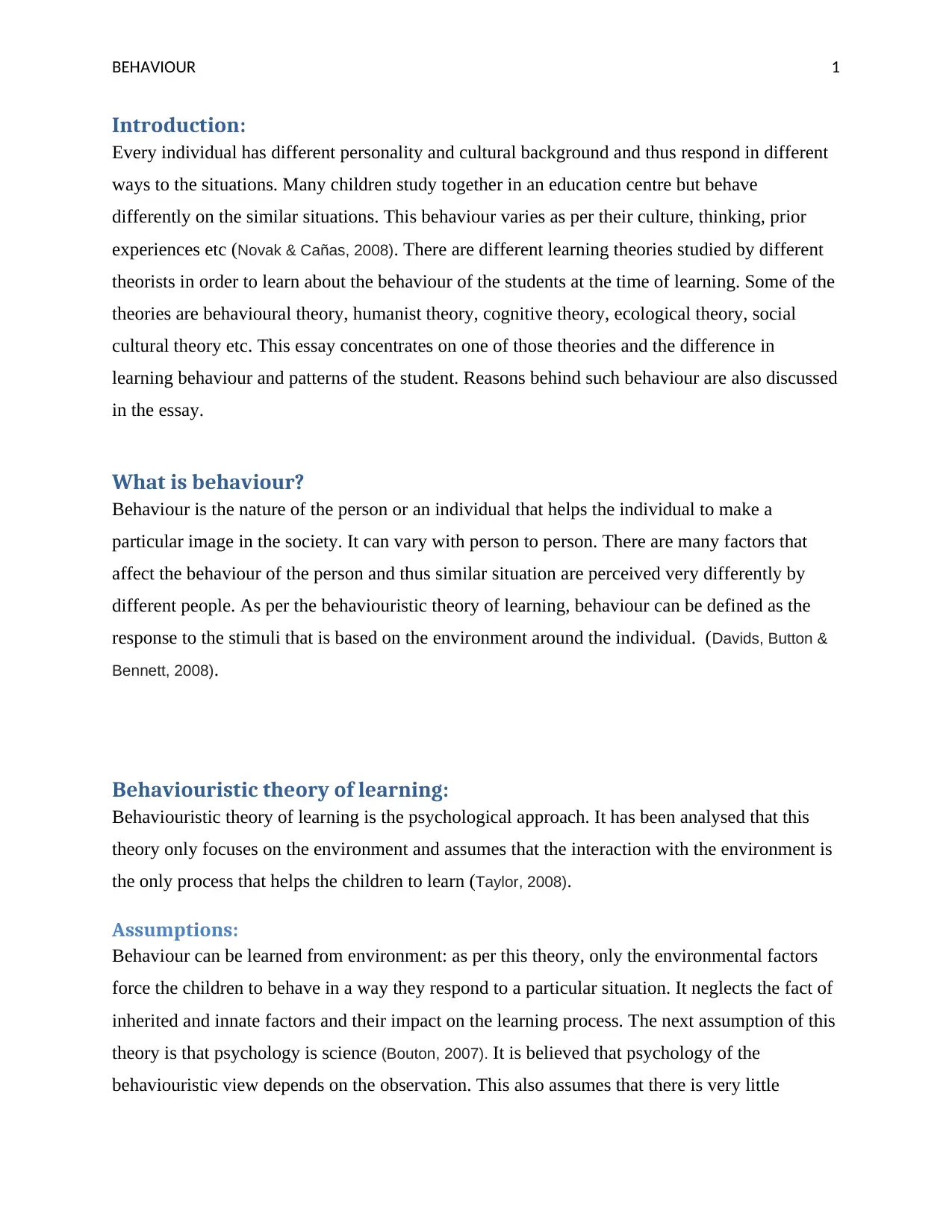
BEHAVIOUR 1
Introduction:
Every individual has different personality and cultural background and thus respond in different
ways to the situations. Many children study together in an education centre but behave
differently on the similar situations. This behaviour varies as per their culture, thinking, prior
experiences etc (Novak & Cañas, 2008). There are different learning theories studied by different
theorists in order to learn about the behaviour of the students at the time of learning. Some of the
theories are behavioural theory, humanist theory, cognitive theory, ecological theory, social
cultural theory etc. This essay concentrates on one of those theories and the difference in
learning behaviour and patterns of the student. Reasons behind such behaviour are also discussed
in the essay.
What is behaviour?
Behaviour is the nature of the person or an individual that helps the individual to make a
particular image in the society. It can vary with person to person. There are many factors that
affect the behaviour of the person and thus similar situation are perceived very differently by
different people. As per the behaviouristic theory of learning, behaviour can be defined as the
response to the stimuli that is based on the environment around the individual. (Davids, Button &
Bennett, 2008).
Behaviouristic theory of learning:
Behaviouristic theory of learning is the psychological approach. It has been analysed that this
theory only focuses on the environment and assumes that the interaction with the environment is
the only process that helps the children to learn (Taylor, 2008).
Assumptions:
Behaviour can be learned from environment: as per this theory, only the environmental factors
force the children to behave in a way they respond to a particular situation. It neglects the fact of
inherited and innate factors and their impact on the learning process. The next assumption of this
theory is that psychology is science (Bouton, 2007). It is believed that psychology of the
behaviouristic view depends on the observation. This also assumes that there is very little
Introduction:
Every individual has different personality and cultural background and thus respond in different
ways to the situations. Many children study together in an education centre but behave
differently on the similar situations. This behaviour varies as per their culture, thinking, prior
experiences etc (Novak & Cañas, 2008). There are different learning theories studied by different
theorists in order to learn about the behaviour of the students at the time of learning. Some of the
theories are behavioural theory, humanist theory, cognitive theory, ecological theory, social
cultural theory etc. This essay concentrates on one of those theories and the difference in
learning behaviour and patterns of the student. Reasons behind such behaviour are also discussed
in the essay.
What is behaviour?
Behaviour is the nature of the person or an individual that helps the individual to make a
particular image in the society. It can vary with person to person. There are many factors that
affect the behaviour of the person and thus similar situation are perceived very differently by
different people. As per the behaviouristic theory of learning, behaviour can be defined as the
response to the stimuli that is based on the environment around the individual. (Davids, Button &
Bennett, 2008).
Behaviouristic theory of learning:
Behaviouristic theory of learning is the psychological approach. It has been analysed that this
theory only focuses on the environment and assumes that the interaction with the environment is
the only process that helps the children to learn (Taylor, 2008).
Assumptions:
Behaviour can be learned from environment: as per this theory, only the environmental factors
force the children to behave in a way they respond to a particular situation. It neglects the fact of
inherited and innate factors and their impact on the learning process. The next assumption of this
theory is that psychology is science (Bouton, 2007). It is believed that psychology of the
behaviouristic view depends on the observation. This also assumes that there is very little
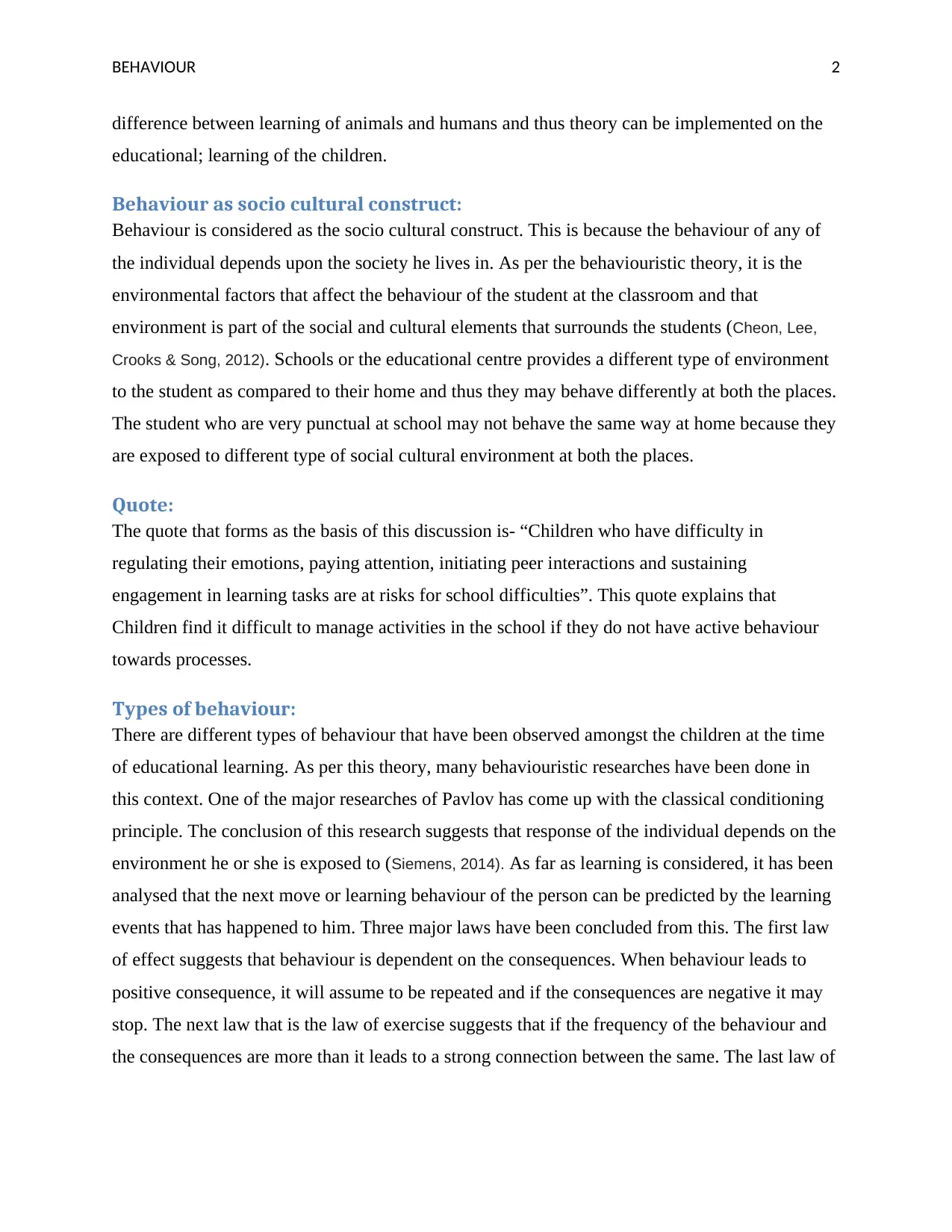
BEHAVIOUR 2
difference between learning of animals and humans and thus theory can be implemented on the
educational; learning of the children.
Behaviour as socio cultural construct:
Behaviour is considered as the socio cultural construct. This is because the behaviour of any of
the individual depends upon the society he lives in. As per the behaviouristic theory, it is the
environmental factors that affect the behaviour of the student at the classroom and that
environment is part of the social and cultural elements that surrounds the students (Cheon, Lee,
Crooks & Song, 2012). Schools or the educational centre provides a different type of environment
to the student as compared to their home and thus they may behave differently at both the places.
The student who are very punctual at school may not behave the same way at home because they
are exposed to different type of social cultural environment at both the places.
Quote:
The quote that forms as the basis of this discussion is- “Children who have difficulty in
regulating their emotions, paying attention, initiating peer interactions and sustaining
engagement in learning tasks are at risks for school difficulties”. This quote explains that
Children find it difficult to manage activities in the school if they do not have active behaviour
towards processes.
Types of behaviour:
There are different types of behaviour that have been observed amongst the children at the time
of educational learning. As per this theory, many behaviouristic researches have been done in
this context. One of the major researches of Pavlov has come up with the classical conditioning
principle. The conclusion of this research suggests that response of the individual depends on the
environment he or she is exposed to (Siemens, 2014). As far as learning is considered, it has been
analysed that the next move or learning behaviour of the person can be predicted by the learning
events that has happened to him. Three major laws have been concluded from this. The first law
of effect suggests that behaviour is dependent on the consequences. When behaviour leads to
positive consequence, it will assume to be repeated and if the consequences are negative it may
stop. The next law that is the law of exercise suggests that if the frequency of the behaviour and
the consequences are more than it leads to a strong connection between the same. The last law of
difference between learning of animals and humans and thus theory can be implemented on the
educational; learning of the children.
Behaviour as socio cultural construct:
Behaviour is considered as the socio cultural construct. This is because the behaviour of any of
the individual depends upon the society he lives in. As per the behaviouristic theory, it is the
environmental factors that affect the behaviour of the student at the classroom and that
environment is part of the social and cultural elements that surrounds the students (Cheon, Lee,
Crooks & Song, 2012). Schools or the educational centre provides a different type of environment
to the student as compared to their home and thus they may behave differently at both the places.
The student who are very punctual at school may not behave the same way at home because they
are exposed to different type of social cultural environment at both the places.
Quote:
The quote that forms as the basis of this discussion is- “Children who have difficulty in
regulating their emotions, paying attention, initiating peer interactions and sustaining
engagement in learning tasks are at risks for school difficulties”. This quote explains that
Children find it difficult to manage activities in the school if they do not have active behaviour
towards processes.
Types of behaviour:
There are different types of behaviour that have been observed amongst the children at the time
of educational learning. As per this theory, many behaviouristic researches have been done in
this context. One of the major researches of Pavlov has come up with the classical conditioning
principle. The conclusion of this research suggests that response of the individual depends on the
environment he or she is exposed to (Siemens, 2014). As far as learning is considered, it has been
analysed that the next move or learning behaviour of the person can be predicted by the learning
events that has happened to him. Three major laws have been concluded from this. The first law
of effect suggests that behaviour is dependent on the consequences. When behaviour leads to
positive consequence, it will assume to be repeated and if the consequences are negative it may
stop. The next law that is the law of exercise suggests that if the frequency of the behaviour and
the consequences are more than it leads to a strong connection between the same. The last law of
⊘ This is a preview!⊘
Do you want full access?
Subscribe today to unlock all pages.

Trusted by 1+ million students worldwide
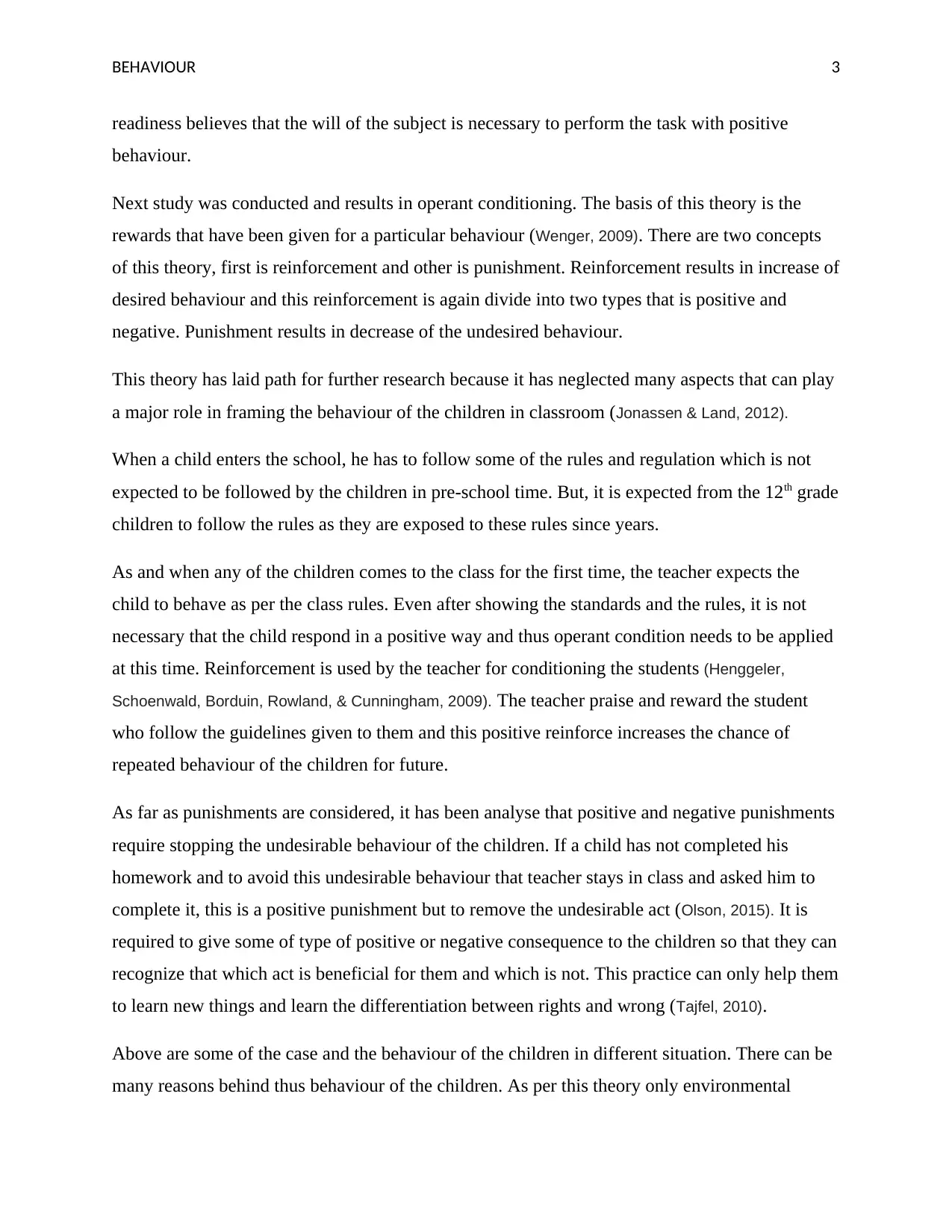
BEHAVIOUR 3
readiness believes that the will of the subject is necessary to perform the task with positive
behaviour.
Next study was conducted and results in operant conditioning. The basis of this theory is the
rewards that have been given for a particular behaviour (Wenger, 2009). There are two concepts
of this theory, first is reinforcement and other is punishment. Reinforcement results in increase of
desired behaviour and this reinforcement is again divide into two types that is positive and
negative. Punishment results in decrease of the undesired behaviour.
This theory has laid path for further research because it has neglected many aspects that can play
a major role in framing the behaviour of the children in classroom (Jonassen & Land, 2012).
When a child enters the school, he has to follow some of the rules and regulation which is not
expected to be followed by the children in pre-school time. But, it is expected from the 12th grade
children to follow the rules as they are exposed to these rules since years.
As and when any of the children comes to the class for the first time, the teacher expects the
child to behave as per the class rules. Even after showing the standards and the rules, it is not
necessary that the child respond in a positive way and thus operant condition needs to be applied
at this time. Reinforcement is used by the teacher for conditioning the students (Henggeler,
Schoenwald, Borduin, Rowland, & Cunningham, 2009). The teacher praise and reward the student
who follow the guidelines given to them and this positive reinforce increases the chance of
repeated behaviour of the children for future.
As far as punishments are considered, it has been analyse that positive and negative punishments
require stopping the undesirable behaviour of the children. If a child has not completed his
homework and to avoid this undesirable behaviour that teacher stays in class and asked him to
complete it, this is a positive punishment but to remove the undesirable act (Olson, 2015). It is
required to give some of type of positive or negative consequence to the children so that they can
recognize that which act is beneficial for them and which is not. This practice can only help them
to learn new things and learn the differentiation between rights and wrong (Tajfel, 2010).
Above are some of the case and the behaviour of the children in different situation. There can be
many reasons behind thus behaviour of the children. As per this theory only environmental
readiness believes that the will of the subject is necessary to perform the task with positive
behaviour.
Next study was conducted and results in operant conditioning. The basis of this theory is the
rewards that have been given for a particular behaviour (Wenger, 2009). There are two concepts
of this theory, first is reinforcement and other is punishment. Reinforcement results in increase of
desired behaviour and this reinforcement is again divide into two types that is positive and
negative. Punishment results in decrease of the undesired behaviour.
This theory has laid path for further research because it has neglected many aspects that can play
a major role in framing the behaviour of the children in classroom (Jonassen & Land, 2012).
When a child enters the school, he has to follow some of the rules and regulation which is not
expected to be followed by the children in pre-school time. But, it is expected from the 12th grade
children to follow the rules as they are exposed to these rules since years.
As and when any of the children comes to the class for the first time, the teacher expects the
child to behave as per the class rules. Even after showing the standards and the rules, it is not
necessary that the child respond in a positive way and thus operant condition needs to be applied
at this time. Reinforcement is used by the teacher for conditioning the students (Henggeler,
Schoenwald, Borduin, Rowland, & Cunningham, 2009). The teacher praise and reward the student
who follow the guidelines given to them and this positive reinforce increases the chance of
repeated behaviour of the children for future.
As far as punishments are considered, it has been analyse that positive and negative punishments
require stopping the undesirable behaviour of the children. If a child has not completed his
homework and to avoid this undesirable behaviour that teacher stays in class and asked him to
complete it, this is a positive punishment but to remove the undesirable act (Olson, 2015). It is
required to give some of type of positive or negative consequence to the children so that they can
recognize that which act is beneficial for them and which is not. This practice can only help them
to learn new things and learn the differentiation between rights and wrong (Tajfel, 2010).
Above are some of the case and the behaviour of the children in different situation. There can be
many reasons behind thus behaviour of the children. As per this theory only environmental
Paraphrase This Document
Need a fresh take? Get an instant paraphrase of this document with our AI Paraphraser
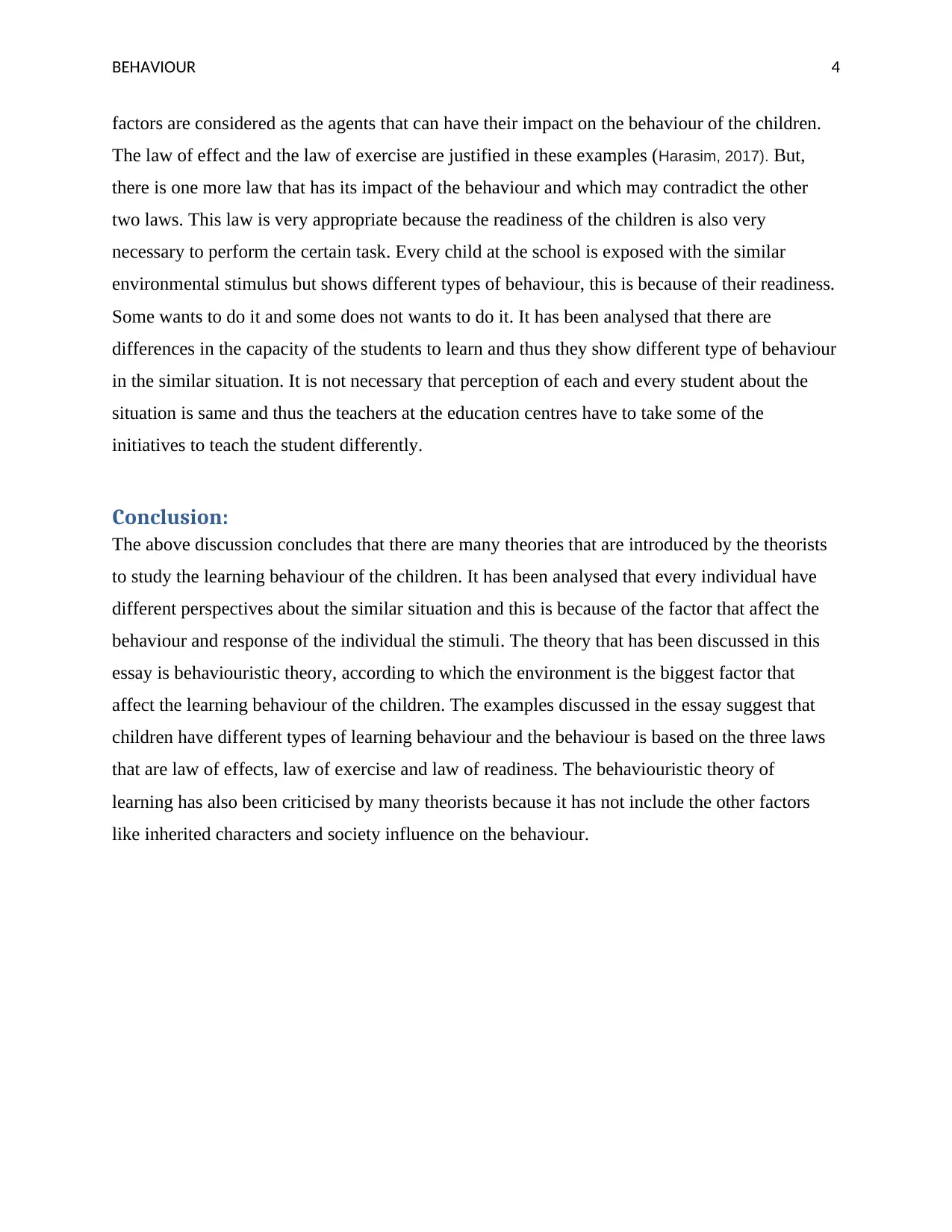
BEHAVIOUR 4
factors are considered as the agents that can have their impact on the behaviour of the children.
The law of effect and the law of exercise are justified in these examples (Harasim, 2017). But,
there is one more law that has its impact of the behaviour and which may contradict the other
two laws. This law is very appropriate because the readiness of the children is also very
necessary to perform the certain task. Every child at the school is exposed with the similar
environmental stimulus but shows different types of behaviour, this is because of their readiness.
Some wants to do it and some does not wants to do it. It has been analysed that there are
differences in the capacity of the students to learn and thus they show different type of behaviour
in the similar situation. It is not necessary that perception of each and every student about the
situation is same and thus the teachers at the education centres have to take some of the
initiatives to teach the student differently.
Conclusion:
The above discussion concludes that there are many theories that are introduced by the theorists
to study the learning behaviour of the children. It has been analysed that every individual have
different perspectives about the similar situation and this is because of the factor that affect the
behaviour and response of the individual the stimuli. The theory that has been discussed in this
essay is behaviouristic theory, according to which the environment is the biggest factor that
affect the learning behaviour of the children. The examples discussed in the essay suggest that
children have different types of learning behaviour and the behaviour is based on the three laws
that are law of effects, law of exercise and law of readiness. The behaviouristic theory of
learning has also been criticised by many theorists because it has not include the other factors
like inherited characters and society influence on the behaviour.
factors are considered as the agents that can have their impact on the behaviour of the children.
The law of effect and the law of exercise are justified in these examples (Harasim, 2017). But,
there is one more law that has its impact of the behaviour and which may contradict the other
two laws. This law is very appropriate because the readiness of the children is also very
necessary to perform the certain task. Every child at the school is exposed with the similar
environmental stimulus but shows different types of behaviour, this is because of their readiness.
Some wants to do it and some does not wants to do it. It has been analysed that there are
differences in the capacity of the students to learn and thus they show different type of behaviour
in the similar situation. It is not necessary that perception of each and every student about the
situation is same and thus the teachers at the education centres have to take some of the
initiatives to teach the student differently.
Conclusion:
The above discussion concludes that there are many theories that are introduced by the theorists
to study the learning behaviour of the children. It has been analysed that every individual have
different perspectives about the similar situation and this is because of the factor that affect the
behaviour and response of the individual the stimuli. The theory that has been discussed in this
essay is behaviouristic theory, according to which the environment is the biggest factor that
affect the learning behaviour of the children. The examples discussed in the essay suggest that
children have different types of learning behaviour and the behaviour is based on the three laws
that are law of effects, law of exercise and law of readiness. The behaviouristic theory of
learning has also been criticised by many theorists because it has not include the other factors
like inherited characters and society influence on the behaviour.
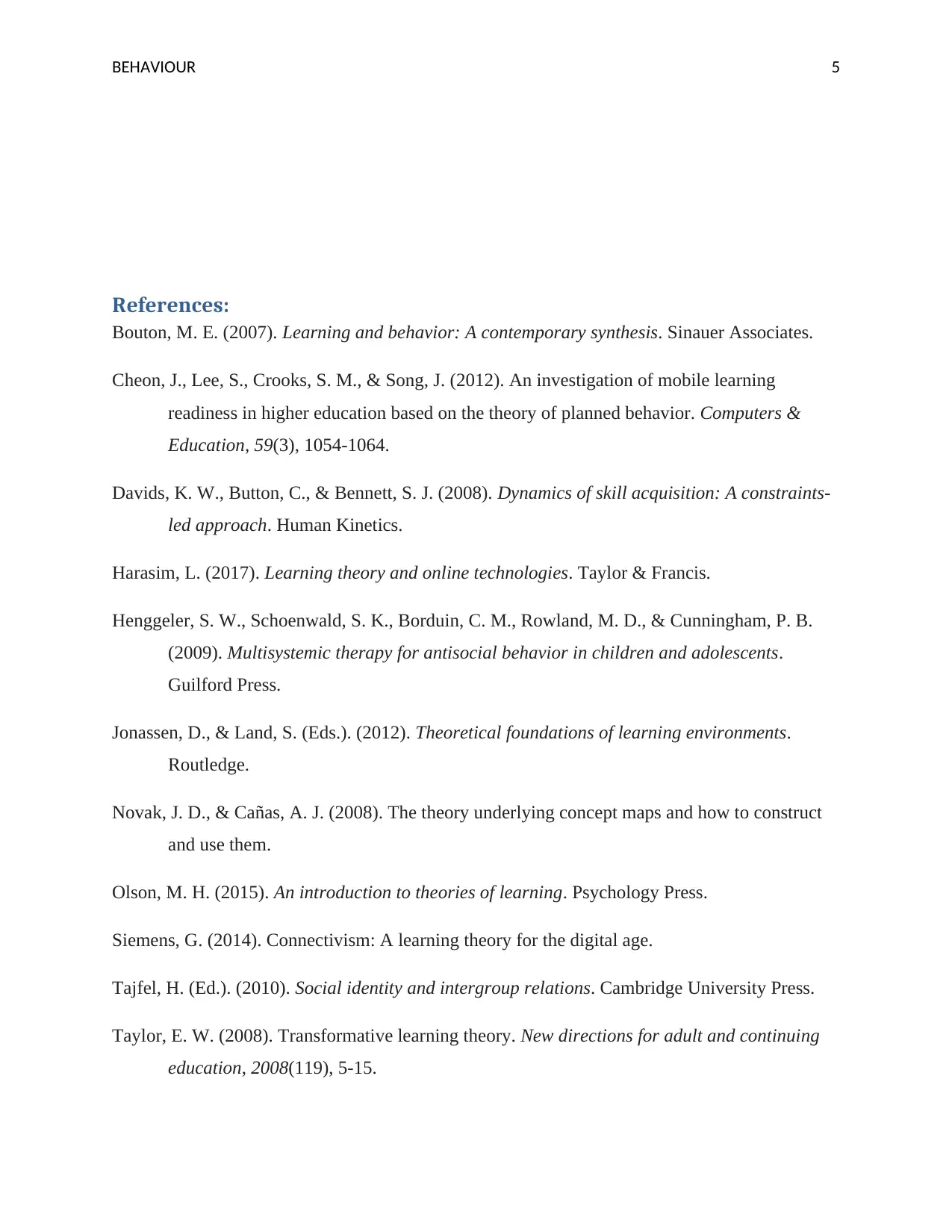
BEHAVIOUR 5
References:
Bouton, M. E. (2007). Learning and behavior: A contemporary synthesis. Sinauer Associates.
Cheon, J., Lee, S., Crooks, S. M., & Song, J. (2012). An investigation of mobile learning
readiness in higher education based on the theory of planned behavior. Computers &
Education, 59(3), 1054-1064.
Davids, K. W., Button, C., & Bennett, S. J. (2008). Dynamics of skill acquisition: A constraints-
led approach. Human Kinetics.
Harasim, L. (2017). Learning theory and online technologies. Taylor & Francis.
Henggeler, S. W., Schoenwald, S. K., Borduin, C. M., Rowland, M. D., & Cunningham, P. B.
(2009). Multisystemic therapy for antisocial behavior in children and adolescents.
Guilford Press.
Jonassen, D., & Land, S. (Eds.). (2012). Theoretical foundations of learning environments.
Routledge.
Novak, J. D., & Cañas, A. J. (2008). The theory underlying concept maps and how to construct
and use them.
Olson, M. H. (2015). An introduction to theories of learning. Psychology Press.
Siemens, G. (2014). Connectivism: A learning theory for the digital age.
Tajfel, H. (Ed.). (2010). Social identity and intergroup relations. Cambridge University Press.
Taylor, E. W. (2008). Transformative learning theory. New directions for adult and continuing
education, 2008(119), 5-15.
References:
Bouton, M. E. (2007). Learning and behavior: A contemporary synthesis. Sinauer Associates.
Cheon, J., Lee, S., Crooks, S. M., & Song, J. (2012). An investigation of mobile learning
readiness in higher education based on the theory of planned behavior. Computers &
Education, 59(3), 1054-1064.
Davids, K. W., Button, C., & Bennett, S. J. (2008). Dynamics of skill acquisition: A constraints-
led approach. Human Kinetics.
Harasim, L. (2017). Learning theory and online technologies. Taylor & Francis.
Henggeler, S. W., Schoenwald, S. K., Borduin, C. M., Rowland, M. D., & Cunningham, P. B.
(2009). Multisystemic therapy for antisocial behavior in children and adolescents.
Guilford Press.
Jonassen, D., & Land, S. (Eds.). (2012). Theoretical foundations of learning environments.
Routledge.
Novak, J. D., & Cañas, A. J. (2008). The theory underlying concept maps and how to construct
and use them.
Olson, M. H. (2015). An introduction to theories of learning. Psychology Press.
Siemens, G. (2014). Connectivism: A learning theory for the digital age.
Tajfel, H. (Ed.). (2010). Social identity and intergroup relations. Cambridge University Press.
Taylor, E. W. (2008). Transformative learning theory. New directions for adult and continuing
education, 2008(119), 5-15.
⊘ This is a preview!⊘
Do you want full access?
Subscribe today to unlock all pages.

Trusted by 1+ million students worldwide
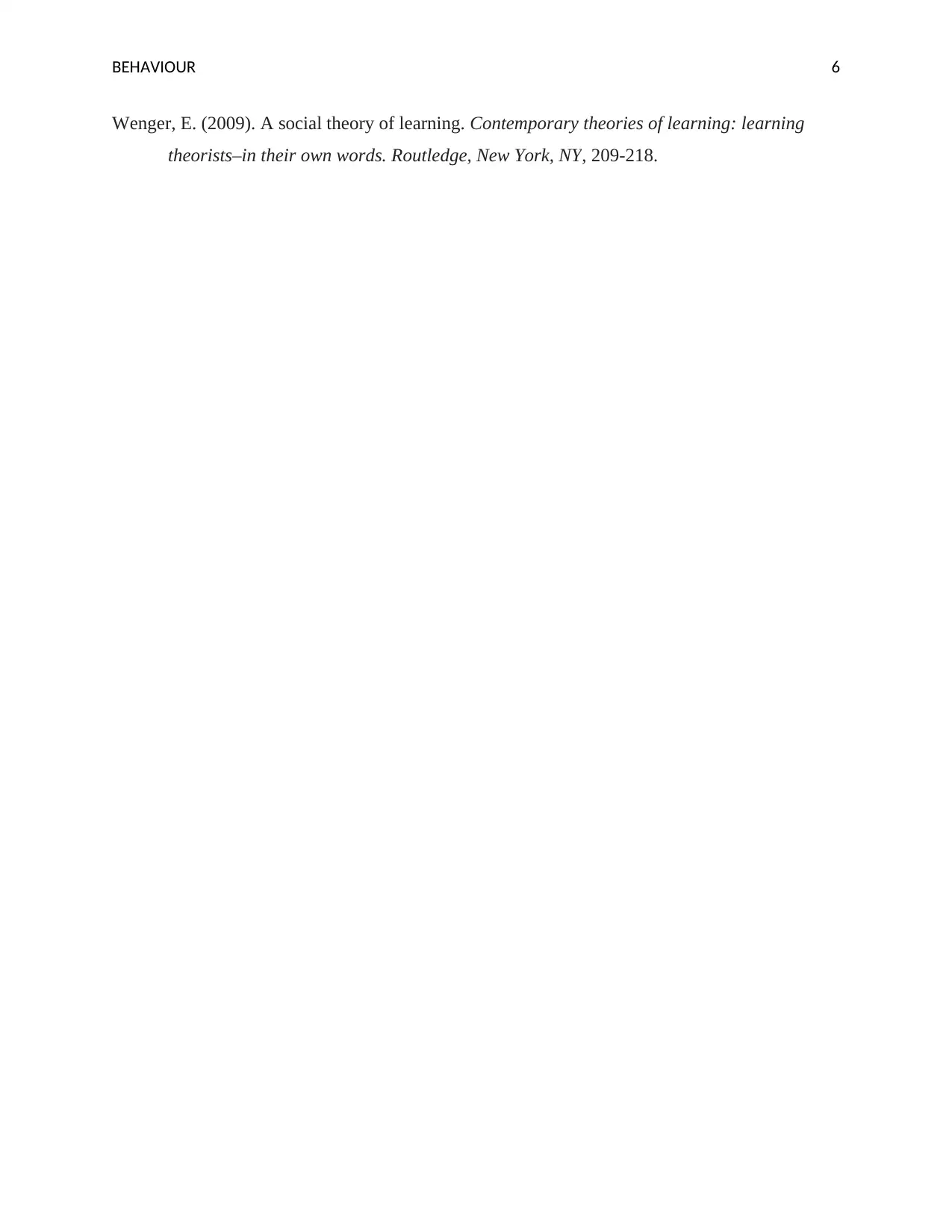
BEHAVIOUR 6
Wenger, E. (2009). A social theory of learning. Contemporary theories of learning: learning
theorists–in their own words. Routledge, New York, NY, 209-218.
Wenger, E. (2009). A social theory of learning. Contemporary theories of learning: learning
theorists–in their own words. Routledge, New York, NY, 209-218.
1 out of 7
Related Documents
Your All-in-One AI-Powered Toolkit for Academic Success.
+13062052269
info@desklib.com
Available 24*7 on WhatsApp / Email
![[object Object]](/_next/static/media/star-bottom.7253800d.svg)
Unlock your academic potential
Copyright © 2020–2025 A2Z Services. All Rights Reserved. Developed and managed by ZUCOL.




